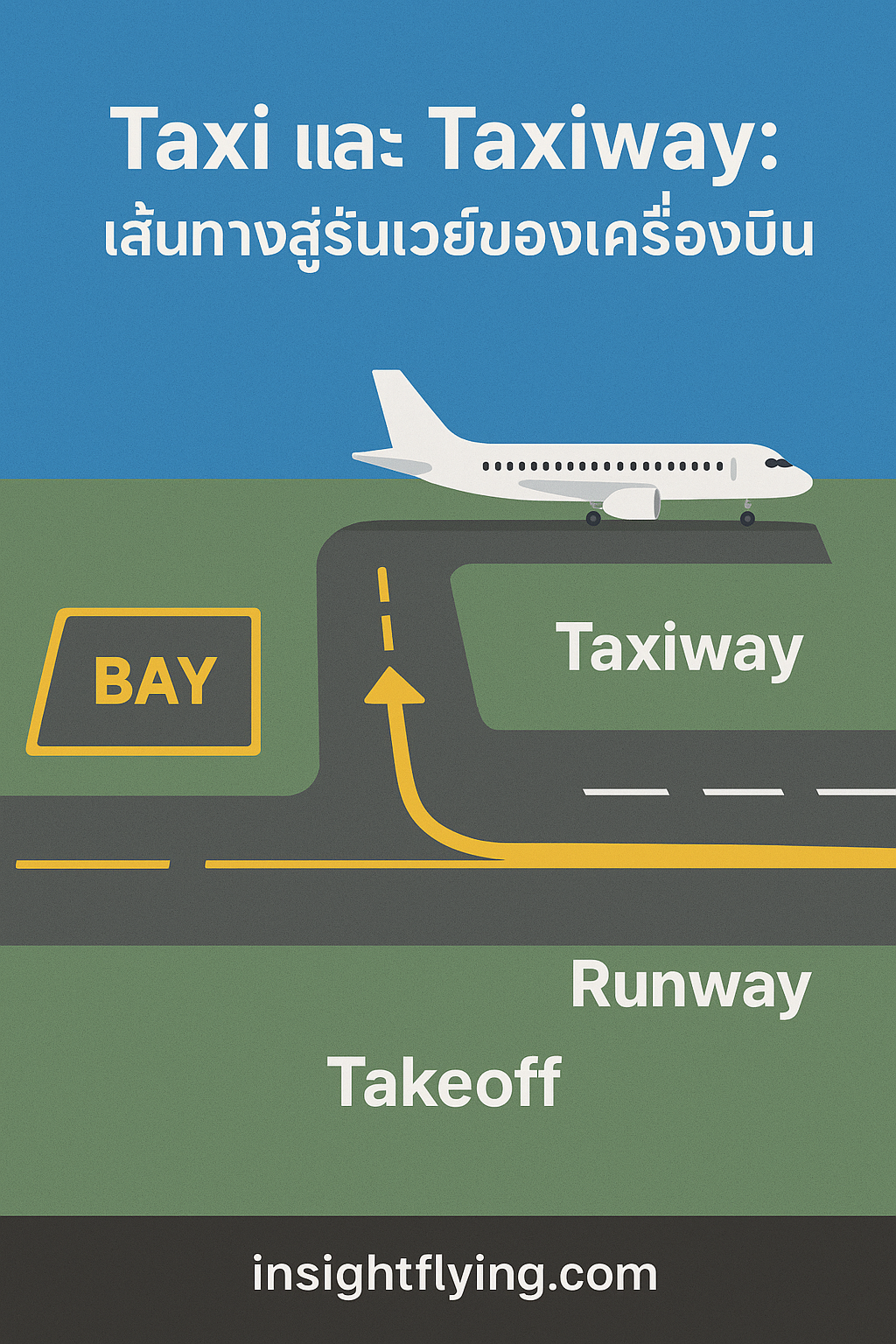เมื่อผู้โดยสารนั่งประจำที่แล้วและเครื่องบินกำลังจะเริ่มออกเดินทาง สิ่งแรกที่เครื่องบินทำไม่ใช่การวิ่งขึ้นทันที แต่คือการ Taxi หรือการเคลื่อนที่ด้วยกำลังเครื่องยนต์ไปตามเส้นทางที่เรียกว่า Taxiway (ทางขับ) เพื่อนำเครื่องบินจาก หลุมจอด (Parking Bay) ไปยัง รันเวย์ (Runway) หรือในทางกลับกันหลังจากลงจอด
🚦 Taxiway คืออะไร?
- Taxiway (ทางขับ): เส้นทางที่เชื่อมระหว่างหลุมจอดและรันเวย์ มีลักษณะคล้ายถนนเฉพาะสำหรับเครื่องบิน
- แต่ละเส้นจะมีชื่อรหัส เช่น Taxiway A, B, C เพื่อให้นักบินและหอบังคับการบิน (ATC) สื่อสารได้ชัดเจน
- ป้ายบอกชื่อ Taxiway จะเป็นสีดำตัวอักษณะเหลือง และป้ายทิศทางจะเป็นพื้นเหลืองตัวอักษรดำ
🛫 การควบคุมบนพื้นดิน: Ground Control
ก่อนเครื่องบินจะเคลื่อนที่ นักบินต้องขออนุญาตจาก หอบังคับการบิน โดยปกติจะมีการแบ่งหน้าที่ดังนี้:
- Apron Control: ควบคุมการเคลื่อนที่ในพื้นที่ใกล้หลุมจอด (บางสนามบินมีแยก)
- Ground Control: ควบคุมการเคลื่อนที่ของเครื่องบินบน Taxiway จนถึงจุดรอรันเวย์ (Runway Holding Point)
- Tower Control: รับช่วงต่อเมื่อเครื่องบินจะเข้าสู่รันเวย์ เพื่อจัดการจราจรการบินขึ้น–ลง
ตัวอย่างเช่น ที่สนามบินสุวรรณภูมิ ไม่มี Apron Control แยกออกมา ใช้ Ground เพียงความถี่เดียว
🗺️ การทำงานจริง: จากหลุมจอดสู่รันเวย์
- Pushback และ Taxi Out – นักบินได้รับอนุญาตจาก Ground เพื่อออกจากหลุมจอดและวิ่งไปตาม Taxiway ตามเส้นทางที่กำหนด เช่น “Taxi via A, B, hold short runway 19L”
- Runway Holding Point – เครื่องบินหยุดรอ ณ จุดก่อนเข้ารันเวย์ รอ Tower อนุญาต
- Line Up and Takeoff – Tower ควบคุมการเข้ารันเวย์และการวิ่งขึ้นจนกว่าจะถึงความสูงที่กำหนด (เช่น 1,500 ฟุต)
- Transfer to Departure Control – Tower ส่งต่อการควบคุมให้ Departure Control เพื่อจัดการการไต่ระดับและการเข้าระบบเส้นทางการบิน
🛬 ในสนามบินขนาดเล็ก
สำหรับสนามบินภูมิภาคหรือสนามบินขนาดเล็ก มักใช้เพียง Tower Frequency เพียงความถี่เดียว นักบินจะติดต่อ Tower ตั้งแต่ก่อน Taxi ออกไปจนถึง Takeoff รวมถึงตอนกลับมาลงจอดและ Taxi เข้าไปจอด
✅ สรุป
Taxi และ Taxiway เป็นขั้นตอนสำคัญที่ทำให้เครื่องบินสามารถเคลื่อนที่ได้อย่างปลอดภัยและมีระเบียบ ก่อนจะเข้าสู่การบินจริง การทำงานประสานกันระหว่างนักบินและหอบังคับการบินคือหัวใจสำคัญ เพื่อป้องกันความสับสนและหลีกเลี่ยงอุบัติเหตุบนพื้นดิน ซึ่งเป็นจุดที่เครื่องบินจำนวนมากต้องใช้ร่วมกันในเวลาเดียวกัน
axi and Taxiway: Understanding Aircraft Ground Movements
When most people think of airplanes, they imagine the thrilling moment of takeoff or the graceful landing. Yet, an essential phase of every flight takes place on the ground: taxiing.
What Does “Taxi” Mean in Aviation?
In aviation, to taxi means for an aircraft to move under its own engine power on the ground, usually between a parking stand (parking bay) and a runway. This movement is not random—it follows designated paths called taxiways.
- Taxiway: The “road” that connects parking stands, aprons, and runways.
- Runway: The “highway” where takeoffs and landings occur.
Taxiways are carefully designed and marked with signs, lights, and surface markings. Each taxiway has a unique designation—typically a letter or a combination of letters and numbers (e.g., Taxiway A, Taxiway B2). This system ensures pilots and controllers can communicate efficiently, much like using street names in a city.
Who Controls Taxi Operations?
Aircraft cannot move around an airport freely; every movement must be cleared by Air Traffic Control (ATC) to maintain order and safety. Depending on the size of the airport, different ATC positions may be involved:
- Apron Control (at some airports): Manages movements at the parking stands and the immediate apron area.
- Ground Control: Handles taxiing aircraft on the taxiways and ensures safe routing to and from runways.
- Tower Control: Takes over when an aircraft is about to enter a runway, manages departures and arrivals, and hands aircraft off to Departure Control once airborne.
At major international airports, these responsibilities are clearly divided. For example, at Bangkok’s Suvarnabhumi Airport, Ground Control issues taxi clearances, while Tower Control manages the runway. In contrast, smaller airports may combine all these functions into a single Tower frequency.
Why Is Taxiing So Important?
Taxiing may appear simple compared to flying at 35,000 feet, but it requires precision and coordination:
- Aircraft are large and heavy, with limited visibility from the cockpit.
- Airports can be complex, with dozens of taxiways intersecting.
- Safe separation between moving aircraft is crucial to prevent collisions.
A well-organized taxi system keeps air traffic flowing smoothly and minimizes delays, making it an essential part of modern aviation.
✍️ insightflying.com – Aviation knowledge made simple.
หนังสือการบิน ทางลัดสู่ความเข้าใจที่นำไปใช้งานจริง

|
|

|
|

|
|

|
|

|
|
ขายดีที่สุด

|
|
